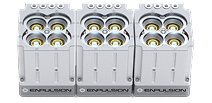FEEP Data Sheets Explained: Understanding Enpulsion’s Performance Mandates
How to Read Enpulsion’s FEEP Data Sheets for Thrust, Power, and Isp Optimization
If you’re just starting to integrate FEEP propulsion systems into your satellite designs, you’ve likely pored over spec sheets to find the right fit for your mission. There are plenty of terms you’ll be familiar with if you’ve been in the industry for any length of time, but the meaning and context of the specifications will be different compared to traditional propulsion systems you’re used to — especially in terms of thrust, power, and Isp values, which work together in a sort of relational triangle.
We’ll walk you through these specs found in each Enpulsion data sheet to help you better understand how to choose the right product for your mission.
Understanding Thrust Performance
Traditional propulsion systems have a fixed thrust with high-force parameters, but FEEP systems turn that on its head. Instead, they offer a dynamic, finely tunable thrust.
Lower thrust ranges, like those in the Nano Lark, are ideal for precision control, minor orbit adjustments, and CubeSats with low delta-v budgets. Meanwhile, large thrust ranges, like those possible with a quad-configured Nexus Osprey, have enough power for orbit raising, deorbiting, or repositioning larger spacecraft.
Key takeaway: Choose a lower-thrust range for fine maneuvering, station-keeping, or drag compensation, and a higher-thrust variant for tasks that require more power, like dynamic orbit maneuvers or major orbit transfers.
Understanding Specific Impulse (Isp)
Isp in an Enpulsion FEEP system is more flexible than other propulsion systems because it doesn’t feature a fixed efficiency level. Instead, you can change Isp in real time based on mission needs and available power, trading thrust for efficiency and vice versa.
This means you can plan high-efficiency, long-duration maneuvers and high-thrust, time-sensitive burns in the same propulsion system.
Key takeaway: Use high Isp for extended delta-v budgets like constellation phasing, and low Isp for time-critical burns under power constraints.
Understanding Power
Thrust and Isp in Enpulsion FEEP systems scale with the total available power. That’s because they depend on external electrical power to ionize and accelerate the propellant rather than a chemical reaction from the fuel.
Budgeting power appropriately is vital to running the system and generating the right amount of thrust.
Keep in mind that the type of emitter you choose for your system will impact thrust efficiency and total impulse; your selection determines how efficiently the system can use the power supplied.
- Alpha emitters are the best balance between price and performance, and are an excellent option for standard missions. This emitter is optimal for commercial constellations.
- Gamma emitters have guaranteed peak performance when you need every last bit of thrust. These are best used for missions in deep space, exploration, or where emitter output is taken to extremes.
Key takeaway: Ensure your mission’s power system can support your desired thrust/Isp profile, and select the right emitter type to optimize for cost and performance.
Understanding the relationship between all three
Thrust, power, and specific impulse are all connected when selecting FEEP systems for your mission, and you should consider them from a position of tradeoffs. Each parameter influences the other, but the combination of all three offers the flexibility you need to match your mission profile.
You can optimize for agility, raw power, precision, or longevity. You can also follow different parameters based on a specific mission cycle. Our data sheets will give you the information you need to find the best ranges for your application.
[Download Enpulsion Data Sheets]
Have more questions that aren’t answered in our data sheets? Do you need some further clarification or support? Whatever you’re looking for, our in-house experts are here to help. Contact us to talk about your mission today.
Get the latest information on Enpulsion innovation.
Subscribe to stay up to date on Enpulsion news, technology updates, and industry events.





